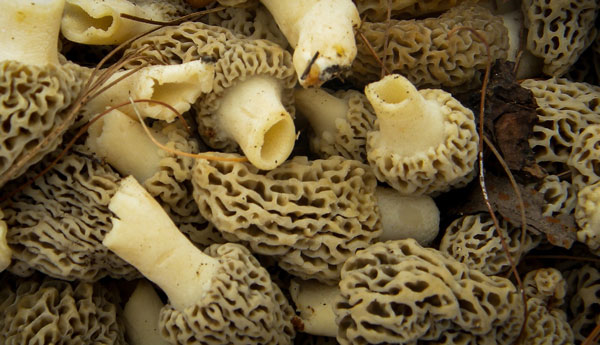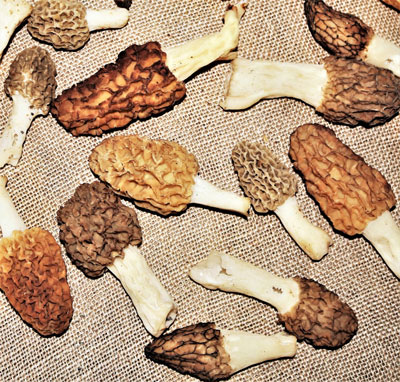
Foraging for mushrooms is an art shrouded in mystery. Doubtless, you’ve heard the stories of first-time foragers taking an accidental trip, or even experienced hands dropping dead from a misidentified specimen. To be quite honest, there’s truth in a lot of those stories (okay, probably not that first one. Psilocybes don’t exactly grow on trees), but the second is more common than most are comfortable with, myself included. As a result, the only kind of mushroom I pick is one with little to no chance of misidentification: the popular morel.
Morels
Chances are you’ve heard of these before, perhaps in conversation with your outdoorsy friend. There’s a reason for this; morels look wildly different from most mushrooms out there, and thus are the most popular target for amateur mushroom collectors. Scientifically termed the Morchella, or True Morel, they are a sac fungi, with a honeycombed network of ridges and pits on their caps. Part of their appeal is they defy usual cultivation methods, making them extremely difficult to farm commercially. Thus their wild collection has become an actual industry in the northern hemisphere, not to mention a fun pastime for the sustainable do-it-yourselfer.
 Identification
Identification
Describing the exterior appearance of a true morel beyond “dark colored, with pits and ridges,” is quite difficult, so just take a look at some of the samples to the right for a good idea. To ensure this is, in fact, a morel however, there are some more definitive tests you can do once you’ve picked it. First, sliced lengthwise, a true morel is completely hollow. The cap is also fully connected to the stem, rather than hanging free (one exception to this is the half-free morel, which is indeed a true morel). The cap will generally be longer than the stem, and the spore print (the trace a mushroom leaves on paper when pressed against it), should be a light cream color to yellow. Finally, morels can be found anytime from February to June (the cooler your area, the later it will be), and are often around apple, elm and the currently beleaguered ash tree. Early in the season, open south-facing slopes will be your best bet; later, north-facing wooded areas will yield more success. Avoid morels that are spongy or wet, though the latter obviously does not apply after a strong rain.
False Friends
Note that above I did say there is little to no chance of misidentification. As with most things in life, there’s always an exception, though this one is relatively easy to not fall afoul of. False Morels come generally in two forms, Verpa and Gyromitrin. They are generally larger, and their caps will often look misshapen or squashed, hanging freely off the stem. The surefire way to identify a False Morel, however? Cut it lengthwise. Whereas a True Morel will be hollow, a False will be full of white fibers. While some cultures maintain that False Morels can be eaten if prepared properly, if they are not, they can result in severe gastric issues, or in extreme cases even death. Best not to take the risk.
Preparation
Here’s a fun fact: True Morels are poisonous. That’s right, you heard me correctly. Fortunately, that’s actually the case for a lot of food in your refrigerator before you cook it. Likewise, once cooked, morels are perfectly safe to eat. Start by checking them closely for worms and other unwelcome guests, the former of which can often be identified by a silky white spot. It’s perfectly common to find them; when you do, just pick them out. Once complete, wash away all the dirt and debris with water. Slice away the tough stem, then section the caps out lengthwise, which will also ensure proper identification. Sear them in olive oil over high heat, browning them with some diced onions and garlic, then melt in a Paula-Deen-sized portion of butter. Add some soy sauce and citrus juice of your choice (I like lemon), and you’re almost done. From here, salt, pepper, and add herbs like parsley or rosemary to your personal taste. Do note, however, that this recipe is easy to over salt, likely on account of the soy, so err on the lighter side. I find morels prepared this way pair best with a nice section of venison backstrap, marinated in olive-oil and red-wine vinegar. Enjoy!
A humble homesteader based in an undisclosed location, Lars Drecker splits his time between tending his little slice of self-sustaining heaven, and bothering his neighbors to do his work for him. This is mainly the fault of a debilitating predilection for fishing, hunting, camping and all other things outdoors. When not engaged in any of the above activities, you can normally find him broken down on the side of the road, in some piece of junk he just “fixed-up.”

Stephen Replogle says
Puffballs are another very safe mushroom class.